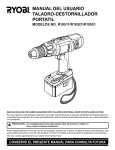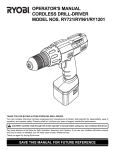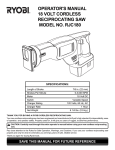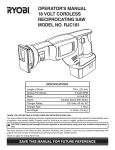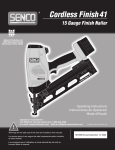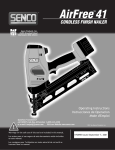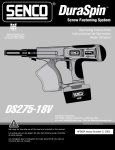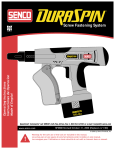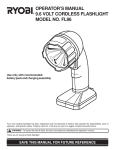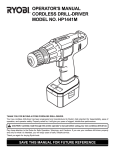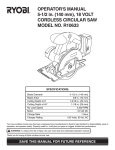Download Ryobi R10531 Operator`s manual
Transcript
OPERATOR'S MANUAL CORDLESS DRILL-DRIVER 20 2 4 ✒ MODEL NOS. R10511/R10521/R10531 THANK YOU FOR BUYING A RYOBI CORDLESS DRILL-DRIVER. Your new cordless drill-driver has been engineered and manufactured to Ryobi’s high standard for dependability, ease of operation, and operator safety. Properly cared for, it will give you years of rugged, trouble-free performance. CAUTION: Carefully read through this entire operator’s manual before using your new cordless drill-driver. Pay close attention to the Rules for Safe Operation, Warnings, and Cautions. If you use your cordless drill-driver properly and only for what it is intended, you will enjoy years of safe, reliable service. Thank you again for buying Ryobi tools. SAVE THIS MANUAL FOR FUTURE REFERENCE TABLE OF CONTENTS ■ Table Of Contents/Typical Applications. ................................................................................ 2 ■ Rules For Safe Operation...................................................................................................3-5 A. Precautions On Using Your Cordless Tool ....................................................................... 4 B. Important Safety Instructions For Charger ....................................................................4-5 C. Precautions Regarding The Use Of Charger And Battery ............................................... 5 ■ Specifications ........................................................................................................................ 6 ■ Important Information For Recharging Hot Batteries............................................................. 6 ■ Operation ..........................................................................................................................7-12 ■ Maintenance ........................................................................................................................ 13 ■ Disposal Of The Exhausted Battery .................................................................................... 13 A. Battery Pack Preparation For Recycling ........................................................................ 13 ■ Service Information ............................................................................................................. 14 CAUTION: Carefully read through this entire manual before using your new drill-driver. Look for this symbol to point out important safety precautions. It means attention!!! Your safety is involved. TYPICAL APPLICATIONS 15 DRILLING Page 2 20 RULES FOR SAFE OPERATION The purpose of safety symbols is to attract your attention to possible dangers. The safety symbols, and the explanations with them, deserve your careful attention and understanding. The safety warnings do not by themselves eliminate any danger. The instructions or warnings they give are not substitutes for proper accident prevention measures. SYMBOL MEANING SAFETY ALERT SYMBOL: Indicates danger, warning, or caution. May be used in conjunction with other symbols or pictographs. DANGER: Failure to obey a safety warning will result in serious injury to yourself or to others. Always follow the safety precautions to reduce the risk of fire, electric shock, and personal injury. WARNING: Failure to obey a safety warning can result in serious injury to yourself or to others. Always follow the safety precautions to reduce the risk of fire, electric shock and personal injury. CAUTION: Failure to obey a safety warning may result in property damage or personal injury to yourself or to others. Always follow the safety precautions to reduce the risk of fire, electric shock and personal injury. NOTE: Advises you of information or instructions vital to the operation or maintenance of the equipment. KNOW YOUR CORDLESS TOOL READ ALL INSTRUCTIONS Safe operation of this cordless tool requires that you read and understand this Operator's Manual and all labels affixed to the tool. Learn its applications and limitations as well as the potential hazards related to a cordless tool. Keep this manual readily available for future reference. IMPORTANT Servicing of a tool requires extreme care and knowledge of the system and should be performed only by a authorized service technician. For service we suggest you return the tool to your nearest Ryobi Authorized Service Center for repair. When servicing, use only identical Ryobi replacement parts. WARNING: Do not attempt to operate this tool until you have read thoroughly and understand completely all instructions, safety rules, etc. contained in this manual. Failure to comply can result in accidents involving fire, electric shock, or serious personal injury. Save this operator's manual and review it frequently for continuing safe operation, and instructing others who may use this tool. WARNING: When using power tools, basic safety precautions should always be followed to reduce the risk of fire, electric shock, and personal injury, including the following precautions. 1. KEEP THE WORK AREA CLEAN. Cluttered work areas and work benches invite injuries. 2. CONSIDER WORK AREA ENVIRONMENT. Keep work area well lit. Do not use tool in presence of flammable liquids or gases. 3. GUARD AGAINST ELECTRICAL SHOCK BY PREVENTING BODY CONTACT WITH GROUNDED SURFACES. For example: Pipes, radiators, ranges, refrigerator enclosures. 4. KEEP CHILDREN AND VISITORS AWAY. All visitors should wear safety glasses and be kept a safe distance from work area. Do not let visitors contact tool or extension cord. 5. STORE IDLE TOOLS. When not in use tools should be stored in a dry and high or locked-up place - out of the reach of children. 6. DON'T FORCE TOOL. It will do the job better and safer at the rate for which it was designed. 7. USE RIGHT TOOL. Don't force small tool or attachment to do the job of a heavy duty tool. Don't use tool for purpose not intended - for example - A circular saw should never be used for cutting tree limbs or logs. 8. WEAR PROPER APPAREL. Do not wear loose clothing or jewelry that can get caught in tool's moving parts and cause personal injury. Rubber gloves and nonskid footwear are recommended Page 3 RULES FOR SAFE OPERATION (Continued) 9. 10. 11. 12. 13. 14. 15. 16. 17. 18. 19. 20. 21. 22. when working outdoors. Wear protective hair covering to contain long hair and keep it from being drawn into nearby air vents. ALWAYS WEAR SAFETY GLASSES. Everyday eyeglasses have only impact-resistant lenses; they are NOT safety glasses. PROTECT YOUR LUNGS. Wear a face mask or dust mask if operation is dusty. PROTECT YOUR HEARING. Wear hearing protection during extended periods of operation. SECURE WORK. Use clamps or a vise to hold work. It's safer than using your hand and it frees both hands to operate tool. DON'T OVERREACH. Keep proper footing and balance at all times. Do not use on a ladder or unstable support. MAINTAIN TOOLS WITH CARE. Keep tools sharp at all times, and clean for best and safest performance. Follow instructions for lubricating and changing accessories. REMOVE ADJUSTING KEYS AND WRENCHES. Form habit of checking to see that keys and adjusting wrenches are removed from tool before turning it on. AVOID UNINTENTIONAL STARTING. Do not carry the tool with your finger on the switch. Be sure switch is off when installing battery pack. STAY ALERT. Watch what you are doing and use common sense. Do not operate tool when you are tired. Do not rush. CHECK DAMAGED PARTS. Before further use of the tool, a guard or other part that is damaged should be carefully checked to determine that it will operate properly and perform its intended function. Check for alignment of moving parts, binding of moving parts, breakage of parts, mounting, and any other conditions that may affect its operation. A guard or other part that is damaged should be properly repaired or replaced by an authorized service center unless indicated elsewhere in this operator's manual. DO NOT USE TOOL IF SWITCH DOES NOT TURN IT ON AND OFF. Have defective switches replaced by an authorized Ryobi Service Center. DRUGS, ALCOHOL, MEDICATION. Do not operate tool while under the influence of drugs, alcohol, or any medication. INSPECT FOR and remove all nails from lumber before drilling. DO NOT CHARGE BATTERY TOOL IN A DAMP OR WET LOCATION. PRECAUTIONS ON USING YOUR CORDLESS TOOL This product contains Nickel-Cadmium batteries which must be disposed of properly. 1. Be aware that this tool is always in an operating condition, because it does not have to be plugged into an electrical outlet. 2. First, charge the battery. 3. Be sure the battery is snapped in place. 4. When not in use, lock the switch. 5. When operating at a high place, be aware of things below you. 6. Before drilling into walls, ceilings, or floors, make sure that there are no concealed power cables inside. WARNING: Drilling into electrical wiring in walls can cause drill bit and chuck to become electrically live. Do not touch the chuck or metal housing when drilling into a wall; grasp only the insulated handle(s) provided on the tool. IMPORTANT SAFETY INSTRUCTIONS FOR CHARGER 1. SAVE THESE INSTRUCTIONS. This manual contains important safety and operating instructions for charging the battery with the following components: MODEL BATTERY CHARGER R10511 1400652 1400666/1400677 R10521 1400655/1400671 1400656/1400677 R10531 1400672 1400667/1400677 2. Before using battery charger, read all instructions and cautionary markings on (1) battery charger, (2) battery, and (3) products using battery. WARNING: To reduce risk of injury, charge only nickelcadmium type rechargeable batteries. Other types of batteries may burst causing personal injury and damage. 3. Do not expose charger to rain or snow. 4. Use of an attachment not recommended or sold by the battery charger manufacturer may result in a risk of fire, electric shock, or injury to persons. Page 4 RULES FOR SAFE OPERATION (Continued) 5. To reduce risk of damage to electric plug and cord, pull by the plug rather than the cord when disconnecting charger. 6. Make sure cord is located so that it will not be stepped on, tripped over, or otherwise subjected to damage or stress. 7. An extension cord should not be used unless absolutely necessary. Use of improper extension cord could result in a risk of fire and electric shock. If extension cord must be used, make sure: a. That pins on plug of extension cord are the same number, size and shape as those of plug on charger. b. That extension cord is properly wired and in good electrical condition; and c. That wire size is large enough for AC ampere rating of charger as specified below: Cord Length (Feet) 25 ft. 50 ft. 100 ft. Cord Size (AWG) 16 16 16 Note: AWG = American Wire Gage 8. Do not operate charger with damaged cord or plug. Replace immediately. 9. Do not operate charger if it has received a sharp blow, been dropped, or otherwise damaged in any way; take it to a Ryobi Authorized Service Center. 10. Do not disassemble charger; take it to a Ryobi Authorized Service Center when service or repair is required. Incorrect reassembly may result in a risk of electric shock or fire. 11. To reduce risk of electric shock, unplug charger from outlet before attempting any maintenance or cleaning. Turning off controls will not reduce this risk. PRECAUTIONS REGARDING THE USE OF CHARGER AND BATTERY 1. 2. 3. Do not charge battery when temperature is below 50° F (10° C) or above 95° F (35° C). Never attempt to connect two chargers together. The charger is designed to operate on standard household electrical power. Do not attempt to 4. 5. 6. 7. 8. 9. 10. 11. use it on any other voltage. Consecutive charging may cause overheating. If you need to recharge batteries consecutively, wait for about 15 minutes to allow charger to cool. Do not insert foreign matter into the hole for the battery in charger stand. Do not charge by means of an engine generator or DC power source. Do not disassemble the battery. Do not store the tool and battery in locations where the temperature may reach or exceed 104° F (40° C), such as outside sheds or metal buildings in summer. Do not incinerate the battery, even if it is severely damaged or completely worn out. The battery may explode in fire. Battery leakage may occur under conditions of extreme usage or temperature. If liquid comes in contact with skin, wash quickly with soap and water, then with lemon juice or vinegar. If liquid gets in your eyes, wash with water for at least 10 minutes and seek medical attention immediately. Do not short-circuit the battery. WARNING: Some dust created by power sanding, sawing, grinding, drilling, and other construction activities contains chemicals known to cause cancer, birth defects or other reproductive harm. Some examples of these chemicals are: • lead from lead-based paints, • crystalline silica from bricks and cement and other masonry products, and • arsenic and chromium from chemically-treated lumber. Your risk from these exposures varies, depending on how often you do this type of work. To reduce your exposure to these chemicals: work in a well ventilated area, and work with approved safety equipment, such as those dust masks that are specially designed to filter out microscopic particles. SAVE THESE INSTRUCTIONS WARNING: The operation of any power tool can result in foreign objects being thrown into your eyes, which can result in severe eye damage. Before beginning power tool operation, always wear safety goggles or safety glasses with side shields and a full face shield when needed. We recommend Wide Vision Safety Mask for use over eyeglasses or standard safety glasses with side shields. Page 5 SPECIFICATIONS: DRILL-DRIVER R10511 R10521 R10531 Chuck 3/8 in. Keyless 3/8 in. Keyless 1/2 in. Keyless Motor DC Motor 12.0 V DC Motor 14.4 V DC Motor 18.0 V Gear Train Two Speed Two Speed Two Speed Switch Variable Speed Variable Speed Variable Speed No Load Speed 0-400 RPM (Low) 0-1400 RPM (High) 0-400 RPM (Low) 0-1400 RPM (High) 0-400 RPM (Low) 0-1400 RPM (High) Clutch 24 Positions 24 Positions 24 Positions Maximum Torque 250 in./lbs 350 in./lbs 400 in./lbs 1400666/1400677 1400656/1400677 1400667/1400677 Input 120 V, 60 Hz, AC only 120 V, 60 Hz, AC only 120 V, 60 Hz, AC only Charging Voltage 12.0 V 14.4 V 18.0 V Charge Rate 1 Hour 1 Hour 1 Hour CHARGER OVERLOAD (For Model R10531 only) Your drill has a built-in overload protector to protect the motor during overloading or prolonged use. The overload protector automatically activates to break the circuit. When this occurs, allow your drill to cool a few seconds before resuming operation. IMPORTANT INFORMATION FOR RECHARGING HOT BATTERIES USING CHARGER PART NUMBER 1400677 When using your drill-driver continuously, the batteries in your battery pack will become hot. You should let a hot battery pack cool down for approximately 30 minutes before attempting to recharge. When the battery pack becomes discharged and is hot, this will cause the red light on your battery charger to flash. When battery pack cools down, red light will glow continuously indicating fast charging mode, 1 hour charge time. Once the battery pack cools down, it will recharge battery pack in fast charging mode as normal. IMPORTANT INFORMATION FOR RECHARGING HOT BATTERIES USING CHARGER PART NUMBER 1400666, 1400656, OR 1400667 When using your drill-driver continuously, the batteries in your battery pack will become hot. You should let a hot battery pack cool down for approximately 30 minutes before attempting to recharge. When the battery pack becomes discharged and is hot, this will cause the yellow and green lights on your battery charger to come on instead of the red light. The yellow and green lights indicate soft start mode and will switch to green only, indicating slow charge mode. The red light indicates fast charge mode, 1 hour charge time. The green light indicates slow charge mode, requiring overnight charging for batteries to reach full charge. If the green light comes on after letting battery pack cool down, remove it from charger for additional cooling. Once the battery pack cools down, it will recharge battery pack in fast charging mode as normal. Do not leave a hot battery pack in charger until it cools down. The green light will not go off when battery pack cools. If fast charge mode is desired, you must physically remove a hot battery pack from the charger, let it cool, then place it back in charger after it has cooled down. Once the battery pack cools down, it will recharge battery pack in fast charging mode as normal. NOTE: This situation only occurs when continuous use of your drill-driver causes the batteries to become hot. It does not occur under normal circumstances. Refer to "CHARGING YOUR DRILL-DRIVER" for normal recharging of batteries. If the charger does not charge your battery pack under normal circumstances, return both the battery pack and charger to your nearest Ryobi Authorized Repair Center for electrical check. Page 6 OPERATION TORQUE ADJUSTMENT RING TWO SPEED GEAR TRAIN (LO-HI) 4 2 See Figure 1. Before attempting to use any tool, familiarize yourself with all operating features and safety requirements. ✒ KNOW YOUR DRILL-DRIVER 20 WARNING: Do not allow familiarity with tools to make you careless. Remember that a careless fraction of a second is sufficient to inflict severe injury. Note: A bit storage is located on the bottom of your drill and also on the charger. See Figures 1 and 2. KEYLESS CHUCK SWITCH TRIGGER CHARGING YOUR DRILL-DRIVER The battery pack for this tool has been shipped in a low charge condition to prevent possible problems. Therefore, you should charge it prior to use. Note: Batteries will not reach full charge the first time they are charged. Allow several cycles (drilling followed by recharging) for them to fully charge. BIT STORAGE BATTERY PACK GREEN LIGHT "ON" INDICATES FULLY CHARGED OR IN SLOW CHARGING MODE TO CHARGE ■ Charge battery pack only with the charger provided. ■ Make sure power supply is normal house voltage, 120 volts, 60 Hz, AC only. ■ Connect charger to power supply. ■ Place battery pack in charger aligning raised rib in charger with groove in battery pack. ■ Press down on battery pack to be sure contacts on battery pack engage properly with charger contacts. When properly connected, red light will turn on. ■ When your battery pack becomes fully charged, the red light will turn off and the green light will turn on. ■ After normal usage, 1 hour of charge time is required to be fully charged. A minimum charge time of 1-1/2 hours is required to recharge a completely discharged tool. ■ The battery pack will become slightly warm to the touch while charging. This is normal and does not indicate a problem. ■ DO NOT place charger in an area of extreme heat or cold. It will work best at normal room temperature. DIRECTION OF ROTATION SELECTOR YELLOW LIGHT "ON" AND RED LIGHT FLASHING INDICATES DEFECTIVE BATTERY PACK Fig. 1 BATTERY CHARGER RED LIGHT "ON" INDICATES FAST CHARGING MODE BATTERY CHARGER ■ When the batteries become fully charged, unplug your charger from power supply and remove the battery pack. CHARGING WITH CHARGER 1400677 See Figure 2. If red light is flashing, this indicates battery pack is deeply discharged or hot. If battery pack is hot, red light should become steady after battery pack has cooled down. If battery pack is deeply discharged, red light should become steady after voltage has increased, normally within 30 minutes. If after one hour red light is still flashing, this indicates a defective battery pack and should be replaced. Page 7 BATTERY PACK BIT STORAGE Fig. 2 Green light on indicates battery pack is fully charged or in slow charging mode to maintain battery pack charge. Yellow light on and red light flashing indicates defective battery pack. Return battery pack to your nearest Ryobi Authorized Service Center for checking or replacing. OPERATION LED FUNCTION OF CHARGER 1400677 LED WILL BE LIGHTED TO INDICATE STATUS OF CHARGER AND BATTERY PACK: ■ Red LED Lighted = Fast Charging Mode. ■ Green LED Lighted = Fully Charged Or In Slow Charging Mode To Maintain Battery Pack Charge. ■ Red LED Flashing = Hot or Deeply Discharged Battery Pack. Also Defective Battery Pack After 1 hour. ■ Yellow LED Lighted and Red LED Flashing = Defective Battery Pack. CHARGING WITH CHARGER 1400666, 1400656, OR 1400667 See Figure 3. ■ Normally, the yellow and green lights on charger will come on. This indicates charger is in control charge mode and should switch to fast charge mode within 5 minutes. When charger is in fast charge mode the red light will come on. If after a period of 15 minutes the yellow and green lights remain on, remove battery pack, wait 1 minute and reinsert battery pack in charger. If the yellow and green lights continue to remain on after an additional 15 minutes, the battery pack is damaged and will not accept a charge. BATTERY PACK GREEN LIGHT "ON" INDICATES FULLY CHARGED OR IN SLOW CHARGING RED LIGHT "ON" MODE INDICATES FAST CHARGING MODE CHARGER CHARGER YELLOW AND GREEN LIGHTS INDICATE SOFT START MODE Fig. 3 LED FUNCTION OF CHARGER 1400666, 1400656 AND 1400667 LED WILL BE LIGHTED TO INDICATE STATUS OF CHARGER AND BATTERY PACK: ■ Red LED Lighted = Fast Charging Mode. ■ Green LED Lighted = Fully Charged Or In Slow Charging Mode To Maintain Battery Pack. ■ Yellow and Green LED Lighted = Soft Start Mode Or After 1/2 Hour Equals Hot Or Defective Battery Pack. Page 8 OPERATION DIRECTION OF ROTATION SELECTOR WARNING: REVERSE SWITCH TRIGGER 24 If any parts are missing, do not operate tool until the missing parts are replaced. Failure to do so could result in possible serious personal injury. 20 SWITCH See Figure 4. Your drill starts and stops by depressing and releasing the switch trigger. Release the switch trigger to turn drill OFF. VARIABLE SPEED CENTER POSITION (LOCK) FORWARD See Figure 4. Your drill has a variable speed feature in the switch. The switch delivers higher speed and torque with increased trigger pressure. Speed is controlled by the amount of switch trigger depression. Fig. 4 SWITCH LOCK TWO SPEED GEAR TRAIN (LO-HI) See Figure 4. The switch trigger can be locked in the OFF position. This feature helps reduce the possibility of accidental starting when not in use. To lock the switch trigger, place the direction of rotation selector in the center position. LO (1) SPEED ✒ HI (2) 2 4 REVERSIBLE 20 See Figure 4. This tool is reversible. The direction of rotation is controlled by a direction of rotation selector located above the switch trigger. With the drill held in normal operating position, the direction of rotation selector should be positioned to the left of the switch for drilling. The drilling direction is reversed when the selector is to the right of the switch. When the selector is in center position, the switch trigger is locked. Fig. 5 CAUTION: To prevent gear damage, always allow chuck to come to a complete stop before changing the direction of rotation. To stop, release switch trigger and allow the chuck to come to a complete stop. WARNING: Battery tools are always in operating condition. Therefore, switch should always be locked when not in use or when carrying at your side. TWO SPEED GEAR TRAIN See Figure 5. Your drill has a two-speed gear train designed for drilling or driving at LO (1) or HI (2) speeds. A slide switch is located on top of your drill to select either LO (1) or HI (2) speed. When using drill in the LO (1) speed range, speed will decrease and unit will have more power and torque. When using drill in the HI (2) speed range, speed will increase and unit will have less power and torque. Use LO (1) speed for high power and torque applications and HI (2) speed for fast drilling or driving applications. Page 9 OPERATION TO INSTALL BATTERY PACK ■ ■ ■ Place the direction of rotation selector in center position. See Figure 4. Place the battery pack in your drill. Align raised rib on battery pack with groove in drill's battery port. See Figure 6. Make sure the latches on each side of your battery pack snap in place and that battery pack is secured in drill before beginning operation. BATTERY PACK TO REMOVE BATTERY PACK ■ ■ ■ Place the direction of rotation selector in center position. See Figure 4. Locate latches on side of battery pack and depress both sides to release battery pack from drill. See Figure 6. Remove battery pack from your drill. BATTERY PORT LATCHES CAUTION: When placing battery pack in your drill, be sure raised rib on battery pack aligns with groove in drill's battery port and latches snap in place properly. Improper assembly of battery pack can cause damage to internal components. DEPRESS LATCHES TO RELEASE BATTERY PACK Fig. 6 KEYLESS CHUCK See Figure 7. A keyless chuck has been provided with your drill to allow for easy installation and removal of bits. As the name implies, you can hand tighten or release drill bits in the chuck jaws. Arrows on the chuck indicate which direction to rotate the chuck sleeve in order to OPEN (unlock) or CLOSE (tighten) the chuck jaws. Loosen the chuck sleeve by rotating it counterclockwise with one hand. Insert drill bit into the chuck the full length of the jaws, tighten securely by rotating the chuck sleeve in clockwise direction. 20 24 OPEN (UNLOCK) KEYLESS CHUCK WARNING: Do not hold chuck sleeve with one hand and use power of the drill to tighten chuck jaws on drill bit. Chuck sleeve could slip in your hand or your hand could slip and come in contact with rotating drill bit. This could cause an accident resulting in serious personal injury. Page 10 CLOSE (TIGHTEN) CHUCK SLEEVE Fig. 7 OPERATION INSTALLING AND REMOVING BITS ■ Open or close the chuck jaws to a point where the opening is slightly larger than the bit size you intend to use. Also, raise the front of your drill slightly to keep the bit from falling out of the chuck jaws. Insert your drill bit into the chuck the full length of the jaws. See Figure 8. Tighten the chuck jaws on the drill bit. To tighten, grasp and hold the drill with one hand, while rotating the chuck sleeve with your other hand. ■ ■ CHUCK SLEEVE DRILL BIT 24 Place the direction of rotation selector at the center position. This will lock the switch trigger in the off position. 20 ■ CHUCK JAWS Note: Rotate the chuck sleeve in the direction of the arrow marked CLOSE to tighten the chuck jaws. DO NOT use a wrench to tighten or loosen the chuck jaws. RIGHT Fig. 8 ✒ WARNING: 20 2 4 Do not insert drill bit into chuck jaws and tighten as shown in figure 9. This could cause drill bit to be thrown from drill resulting in possible serious personal injury or damage to the chuck. REMOVING BITS See Figure 8. ■ Place the direction of rotation selector at the center position. This will lock the switch trigger in the off position. ■ Loosen the chuck jaws from drill bit. ■ To loosen: grasp and hold the drill with one hand, while rotating chuck sleeve with your other hand. Note: Rotate chuck sleeve in the direction of the arrow marked OPEN to loosen chuck jaws. DO NOT use a wrench to tighten or loosen the chuck jaws. ■ Remove drill bit from chuck jaws. WRONG Fig. 9 DRILLING 15 20 See Figure 10. When drilling hard, smooth surfaces, use a center punch to mark the desired hole location. This will prevent the drill bit from slipping off center as the hole is started. However, the lower speed feature allows starting holes without center punching if desired. To accomplish this, simply operate your drill at lower speed until the hole is started. The material to be drilled should be secured in a vise or with clamps to keep it from turning as the drill bit rotates. Hold tool firmly and place the bit at the point to be drilled. Depress the switch trigger to start tool. Move the drill bit into the workpiece, applying only enough pressure to keep the bit cutting. Do not force or apply side pressure to elongate a hole. Fig. 10 Page 11 OPERATION 20 24 Be prepared for binding or breakthrough. When these situations occur, the drill has a tendency to grab and kick in the opposite direction, and could cause loss of control when breaking through material. If you are not prepared, this loss of control can result in possible serious injury. When drilling metals, use a light oil on the drill bit to keep it from overheating. The oil will prolong the life of the bit and increase the drilling action. If the bit jams in workpiece or if the drill stalls, release switch trigger immediately. Remove the bit from the workpiece and determine the reason for jamming. TO INCREASE TORQUE Fig. 11 SCREWDRIVING TORQUE ADJUSTMENT (Driving power of your drill-driver) When using your drill-driver for various driving applications, it becomes necessary to increase or decrease the torque in order to help prevent the possibility of damaging screw heads, threads, workpiece, etc. In general, torque intensity should correspond to the screw diameter. If the torque is too high or the screws too small, the screws may be damaged or broken. The torque is adjusted by rotating the torque adjustment ring. See Figure 11. The torque is greater when the torque adjustment ring is set on a higher setting. The torque is less when the torque adjustment ring is set on a lower setting. BIT STORAGE AREA SCREWDRIVER BITS The proper setting depends on the type of material and the size of screw you are using. TO ADJUST TORQUE ■ ■ TORQUE ADJUSTMENT RING TO DECREASE TORQUE ✒ WARNING: Identify the twenty four torque indicator settings located on the front of your drill. See Figure 11. Rotate adjustment ring to the desired setting. • 1 For driving small screws. • 1-5 For driving screws into soft material. • 5 - 10 For driving screws into soft and hard materials. • 10 - 15 For driving screws in hard wood. • 15 - 20 For driving large screws. • Drill For heavy drilling. BIT STORAGE Fig. 12 WARNING: Always wear safety goggles or safety glasses with side shields when operating tool. Failure to do so could result in objects being thrown into your eyes, resulting in possible serious injury. CAUTION: Do not attempt to remove or tighten the chuck on your drill. This will damage the spindle lock inside the drill. To remove or tighten the chuck, we suggest you return the tool to your nearest Ryobi Authorized Service Center. See Figure 12. When not in use, bits provided with your drill can be placed in the storage area located at the bottom of your drill as shown in figure 12. Page 12 MAINTENANCE DO NOT ABUSE POWER TOOLS. Abusive practices can damage the tool, as well as the workpiece. WARNING: When servicing use only identical Ryobi replacement parts. Use of any other parts may create a hazard or cause product damage. Avoid using solvents when cleaning plastic parts. Most plastics are susceptible to damage from various types of commercial solvents and may be damaged by their use. Use a clean cloth to remove dirt, oil, grease, etc. WARNING: Do not attempt to modify this tool or create accessories not recommended for use with this tool. Any such alteration or modification is misuse and could result in a hazardous condition leading to possible serious personal injury. WARNING: CAUTION: Do not at any time let brake fluids, gasoline, petroleumbased products, penetrating oils, etc., come in contact with plastic parts. They contain chemicals that can damage, weaken, or destroy plastics. Any repairs requiring disassembly should only be performed by a Ryobi Authorized Service Center. For the repair center nearest you, call 1-800-525-2579. BATTERIES Your drill's battery pack is equipped with Nickel-Cadmium rechargeable batteries. Length of service from each charging will depend on the type of work you are doing. The batteries in this tool have been designed to provide maximum trouble-free life. However, like all batteries, they will eventually wear out. Do not disassemble the battery pack and attempt to replace the batteries. Handling of these batteries, especially when wearing rings and jewelry, could result in a serious burn. To obtain the longest possible battery life, we suggest the following: ■ ■ ■ Store and charge your batteries in a cool area. Temperatures above normal room temperature will shorten battery life. Never store batteries in a discharged condition. Wait for battery to cool and charge immediately. All batteries gradually lose their charge. The higher the temperature, the quicker they lose their charge. If you store your tool for long periods of time without using it, recharge the batteries every month or two. This practice will prolong battery life. DISPOSAL OF THE EXHAUSTED BATTERY To preserve natural resources, please recycle or dispose of properly. This product contains nickel-cadmium batteries. Local, state or federal laws may N i Cd prohibit disposal of nickel-cadmium 00 .822.88 batteries in ordinary trash. Consult your local waste authority for information regarding available recycling and/or disposal options. For more information on battery recycling call 1-8008BATTERY. BATTERY PACK PREPARATION FOR RECYCLING 1.8 WARNING: 37 C YC R ER B R CL E WARNING: Upon removal, cover the battery pack's terminals with heavy duty adhesive tape. Do not attempt to destroy or disassemble battery pack or remove any of its components. Also, never touch both terminals with metal objects and/or body parts, as short circuit may result. Keep away from children. Failure to comply with these warnings could result in fire and/or serious injury. Do not attempt to disassemble the battery pack. Fire or injury may result. Page 13 OPERATOR'S MANUAL CORDLESS DRILL-DRIVER MODEL NOS. R10511/R10521/R10531 • SERVICE Now that you have purchased your tool, should a need ever exist for repair parts or service, simply contact your nearest Ryobi Authorized Service Center. Be sure to provide all pertinent facts when you call or visit. Please refer to the Service Center insert or call 1-800525-2579 in the United States or 1-800-265-6778 in Canada for your nearest Ryobi Authorized Service Center. You can also check our web site at www.ryobi.com for a complete list of Authorized Service Centers. • MODEL NO. AND SERIAL NO. The model number of this tool will be found on a plate attached to the motor housing. Please record the model number and serial number in the space provided below. • HOW TO ORDER REPAIR PARTS WHEN ORDERING REPAIR PARTS, ALWAYS GIVE THE FOLLOWING INFORMATION: • MODEL NUMBER • SERIAL NUMBER R10511/R10521/R10531 RYOBI TECHNOLOGIES INC. 1428 Pearman Dairy Road Anderson, SC 29622 Post Office Box 1207 Anderson, SC 29622-1207 Phone 1-800-525-2579 972000-614 10-00 RYOBI TECHNOLOGIES INC. Post Office Box 910 Cambridge, Ontario N1R 6K2 Phone 1-800-265-6778














